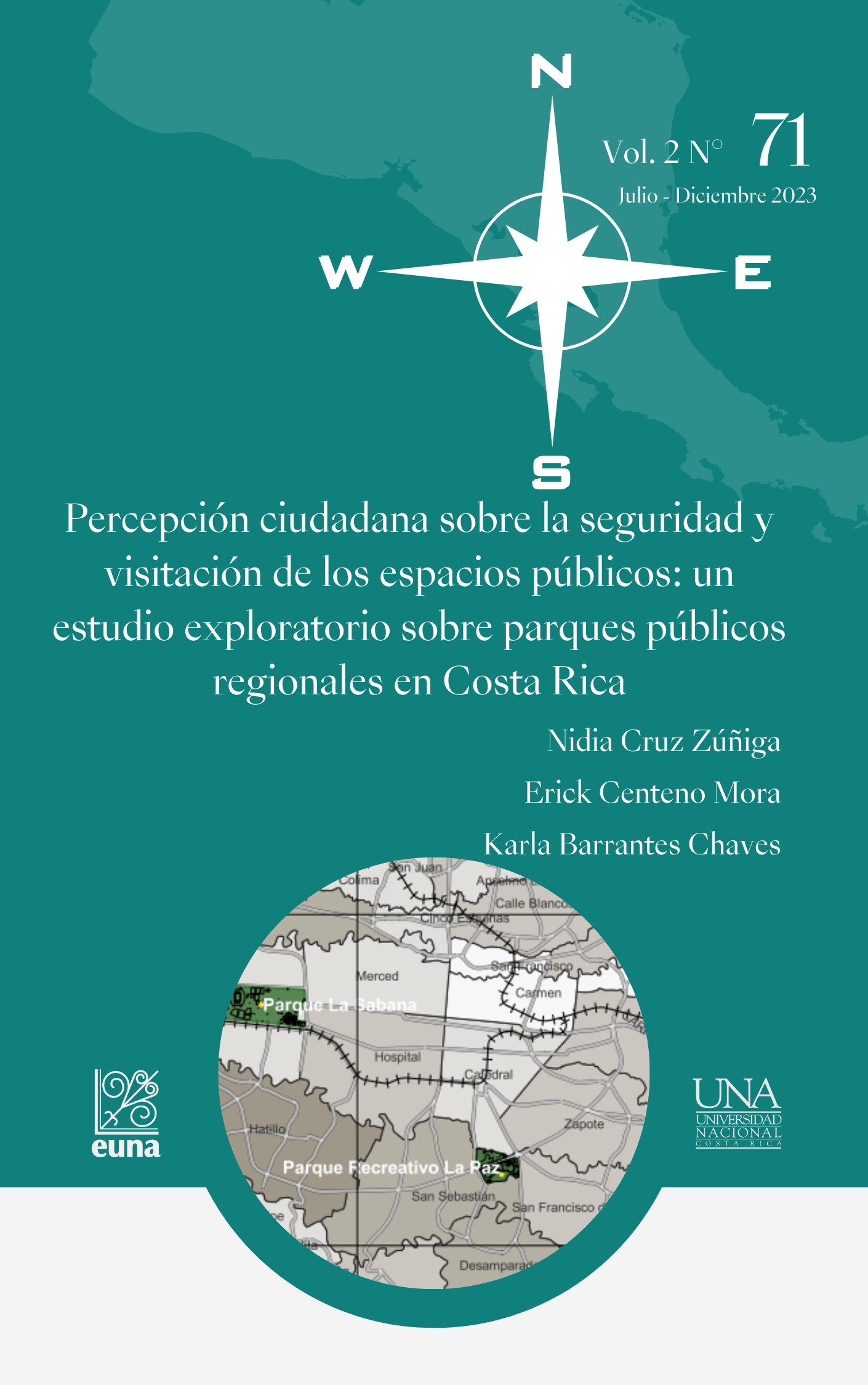Citizen Perception of Security and Visitation of Public Spaces: An Exploratory Study on Regional Public Parks in Costa Rica
DOI:
https://doi.org/10.15359/rgac.71-2.6Keywords:
quality of life, leisure, regional parks, Parks, urban parksAbstract
Through an exploratory approach, this article aimed to investigate the relationship between uses, dynamics, and perception of security from users of three urban regional parks in the metropolitan area of Costa Rica. The information was collected from direct consultation through a closed survey and a predominantly quantitative analysis. One of the main findings highlights that about 60% of surveyed people visited the parks at least once a month. They come from various neighboring cantons, but especially those hosting the parks. In addition, fear of crime influences visitation patterns, especially the hours of use. Also, aspects such as gender and age influence this perception. Finally, it is concluded that existing evidence links the perception of security and visitation patterns to this type of space. Further studies of this type are necessary to have adequate inputs for planning and designing cities, especially in Latin America.
References
Arriagada, C. y Morales, N. (2006). Ciudad y seguridad ciudadana en Chi- le: revisión del rol de la segregación sobre la exposición al delito en grandes urbes. EURE, 32(97), 37-48.
Bolívar, J. (2016). Calidad de vida a través de actividades físicas y recrea- tivas en el centro de adultos mayores Changaimina, cantón Gonza- namá, provincia de Loja. (Tesis de licenciatura). Universidad Nació- nal de Loja.
Borja, J. y Muxi, Z. (2003). El espacio público: ciudad y ciudadanía. Di- putación de Barcelona and Electa.
Ceccato, V. y Bamzar, R. (2016). Elderly Victimization and Fear of Cri- me in Public Spaces. International Criminal Justice Review, 26(2), 115-133.
Chiesura, A. (2004). The role of urban parks for the sustainable city. Landscape and Urban Planning, 68(1), 129-138, doi: 10.1016/J. LANDURBPLAN.2003.08.003.
Cloutier, J. (2001). Petit traité de communication. Telemediatique Inc. Cruz, N., Centeno, E. y Barrantes, K. (2022). Ponencia: Parques Públicos
Regionales, GAM, Costa Rica: patrones de uso y percepciones de personas usuarias. IV Jornadas de Investigación 2022. https://jorna- das.fing.ucr.ac.cr/Presentacion&p=164.
Dwiputra, I., Tampubolon, A., y Kusuma, H.E. (2019). The influence of user activity and environmental characteristics dimensions on sense of place in city parks. Journal of Architecture and Built Environ- ment., 45(2), 165-172, doi: 10.9744/dimensi.45.2.165-172.
Falú, A. (2009). Mujeres en la Ciudad. De violencias y derechos. En: Vio- lencias y discriminaciones en las ciudades pp. 15-37 Red Mujer y Hábitat de América Latina.
González. D. (2018). Derecho humano al tiempo libre y la recreación y su incidencia en la productividad de los trabajadores. Ánfora, 25, 69-90, 2018. doi: 10.30854/anf.v25.n44.2018.392.
Gray, E., Jackson, J. y Farrall, S. (2011). Feelings and Functions in the Fear of Crime: Applying a New Approach to Victimisation Insecuri- ty. British journal of criminology, 51(1), 75-94.
Hale, C. (1996). Fear of Crime: A Review of the Literature. International Review of Victimology, 4(2), 79-150.
Ibarra-García, M. y Escamilla-Herrera, I. (2016). Geografías feministas de diversas latitudes: Orígenes, desarrollo y temática contemporánea.UNAM, Instituto de Geografía.
Instituto Costarricense del Deporte y la Recreación (ICODER). (2018). Misión y visión del Instituto Costarricense del deporte y la recrea- ción. Gobierno de Costa Rica. Recuperado de: https://www.icoder. go.cr/icoder.
Instituto Nacional de Estadísticas y Censos (INEC). (2011). Prevalecen desigualdades por sexo en el uso del tiempo. https://www.inec.cr/ noticia/prevalecen-desigualdades-por-sexo-en-el-uso-del-tiempo
Jacobs, J. (1961). The death and life of great American cities. Modern Library edition.
Koskela, H. y Pain, R. (2000). Revisiting fear and place: women’s fear of attack and the built environment. Geoforum, 31(2), 269-280.
Lebowitz, B.D. (1975). Age and fearfulness: Personal and situational fac- tors. Journal of Gerontology. 30(6), 696-700.
Link, N., Kelly, J., Pitts, J., Waltman-Spreha, K. y Taylor, R. (2017). Re- versing Broken Windows: Evidence of Lagged, Multilevel Impacts of Risk Perceptions on Perceptions of Incivility. Crime and Delin- quency, 63(6), 659-682.
Loukaitou-Sideris, A. (2012). Safe on the Move: The Importance of the Built Environment. En: V. Ceccato (ed.). The Urban Fabric of Crime and Fear. pp. 85-110. Springer Netherlands.
Madanipour, A. (2003). Public and private spaces of the city. Routledge.
Macmillan, R., Nierobisz, A. y Welsh, S. (2000). Experiencing the Streets: Harassment and Perceptions of Safety among Women. The Journal of Research in Crime and Delinquency, 37(3), 306-322.
Melde, C. (2011). Fear of crime. En: R.J.R. Levesque (ed.). Encyclopedia of Adolescence pp. 1007-1015 Springer.
Mihinjac, M. y Saville, G. (2019). Third-Generation Crime Preven- tion Through Environmental Design (CPTED). Social Sciences, 8(6), 182.
Muxí-Martinez, Z. (2011). Introducción. En: Col•lectiu Punt 6. Constru- yendo entornos seguros desde la perspectiva de género. Programa Ciutats i Persones, Institut de Ciències Politiques i Socials pp.3-
Informe número 5. Recuperado de: https://punt6.files.wordpress. com/2011/03/construyendoentornosseguros.pdf
Naredo, M. (1998). Autonomía de las mujeres y seguridad ciudadana. Bo- letín CF+S [Ciudades para un Futuro Más Sostenible]. Colectivo de Mujeres Urbanistas 7.
Ortiz-Escalante, S. (2014). Espacio público, género e (in)seguridad. En: Cortés-Zaborras, C. (ed.) Jornadas Urbanismo y Género. Ciudades en Construcción. Perséfone. pp.48-67. Ediciones electrónicas de la AEHM/UMA.
Pain, R. (1991). Space, sexual violence and social control: integrating geo- graphical and feminist analyses of women’s fear of crime. Progress in Human Geography, 15(4), 415-431.
Sánchez, L. (2018). Tendencias y patrones del crecimiento urbano en la GAM, implicaciones sociales, económicas y ambientales y desafíos desde el Ordenamiento territorial. Informe Estado de La Nación En Desarrollo Humano Sostenible 2018. http://repositorio.conare.ac.cr/ handle/20.500.12337/2982.
Sendra, P. y Sennett, R. (2020). Designing disorder: experiments and dis- ruptions in the city. Verso.
Tandogan, O. y Ilhan, B.S. (2016). Fear of Crime in Public Spaces: From the View of Women Living in Cities. Procedia Engineering, 161, 2011-2018.
Wang, D., Brown, G. y Liu, Y. (2015). The physical and non-physical fac- tors that influence perceived access to urban parks. Landscape and Urban Planning, 133, 53-66.
Weisman, L.K. (1992). Discrimination by design: a feminist critique of the man-made environment. University of Illinois Press

Published
How to Cite
Issue
Section
License
Proposed policy for journals offering Open Access
Authors publishing their works in the Journal acknowledge and agree to the following terms:
a) Authors retain the copyrights to their works and guarantee the Journal the right to be the first to publish their works, under the Creative Commons License Attribution-NonCommercial-ShareAlike 4.0 International, CC BY-NC-SA 4.0 International (https://creativecommons.org/licenses/by-nc-sa/4.0/deed.es), which allows others to share works upon complying with the acknowledgment of authorship and mention of the Journal as the original publisher of the work.
b) Authors are permitted to separately establish additional agreements for the non-exclusive distribution of the official edition of the work published in the Journal (for example, authors may desire to place the work in an institutional repository or incorporate it into a book that is to published elsewhere) so long they acknowledgment to recognize the Journal as the original publisher. The aforementioned additional agreements must respect the terms of the non-profit character and sharing philosophy of the original license (CC BY-NC-SA 4.0 International, https://creativecommons.org/licenses/by-nc-sa/4.0/deed.es).
c) Authors are encouraged to archive the post-print or editor/PDF version in Open Access repositories.






 REVGEO is licensed under https://creativecommons.org/licenses/by-nc-sa/4.0/deed.es
REVGEO is licensed under https://creativecommons.org/licenses/by-nc-sa/4.0/deed.es
.svg_4.png)

_(1).png)
_(1)_(1)_(1)_1.png)
(2)(1)(1)(1).png)
